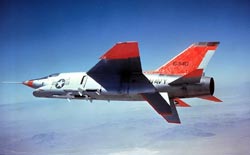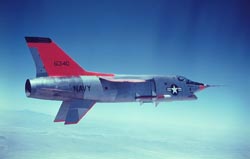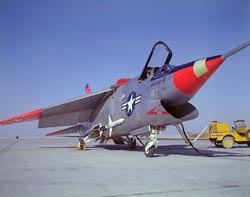|
 Although its appearance is similar to previous F8Us,the XF8U-3 was an entirely new aircraft larger in size and with a bigger powerplant than F8U-1 & -2 aircraft. Although its appearance is similar to previous F8Us,the XF8U-3 was an entirely new aircraft larger in size and with a bigger powerplant than F8U-1 & -2 aircraft.
The first flight of the XF8U-3 was made at Edwards Air Force Base on June 2, 1958, with test pilot John Konrad at the controls. The flight lasted 48 minutes and during which the aircraft attained a speed of 350 knots at 20,000 feet. During subsequent flights, the XF8U-3 achieved a speed of Mach 2.39 (approximately 1,601 mph) and was still accelerating at 0.1 Mach every 17 seconds. This was extraordinary even when compared to the performance of today’s aircraft.
The reason for not flying faster was the heat limitations on the plexiglas windshield, which was approaching an external temperature of 325 degrees F. A design for a laminated glass windshield was under way during the flight test program. This would have allowed the aircraft to achieve its maximum speed potential. It was the opinion of all the test pilots, from the technical data available, that the aircraft could attain a speed close to Mach 2.9 at 35,000 feet (1,950 mph)and there is little doubt that this speed could have been attained. This would have easily made the F8U-3 the fastest jet-propelled fighter– interceptor in the world. This performance, however, could not be maintained for extended periods due to heat soak considerations and the effect of high temperature on the aircraft structure.
 Another area of outstanding performance was acceleration., The F8U-3, powered by the Pratt & Whitney J75-P-6 afterburning engine was the fastest accelerating fighter in the world in acceleration from subsonic to supersonic speeds. From a speed of Mach .98 at 35,000 feet to Mach 2.2, it would take only 3 minutes and 54 seconds compared to a time of 9 minutes for a more conventional fighter of that era. The maximum altitude capability for this aircraft, was also impressive. From a sustained flight altitude of 65,000 feet the aircraft could zoom to an altitude approaching 90,000 feet. One can only imagine what performance the F8U-3 would have achieved with the addition of a rocket engine proposed by the U.S. Navy. However, this configuration never reached the flight test stage due to the cancellation of the rocket project before the installation of hardware. Another area of outstanding performance was acceleration., The F8U-3, powered by the Pratt & Whitney J75-P-6 afterburning engine was the fastest accelerating fighter in the world in acceleration from subsonic to supersonic speeds. From a speed of Mach .98 at 35,000 feet to Mach 2.2, it would take only 3 minutes and 54 seconds compared to a time of 9 minutes for a more conventional fighter of that era. The maximum altitude capability for this aircraft, was also impressive. From a sustained flight altitude of 65,000 feet the aircraft could zoom to an altitude approaching 90,000 feet. One can only imagine what performance the F8U-3 would have achieved with the addition of a rocket engine proposed by the U.S. Navy. However, this configuration never reached the flight test stage due to the cancellation of the rocket project before the installation of hardware.
Three XF8U-3’s were flown during the flight test period, which only lasted a short seven months. During this time, approximately 150 hours was logged on the No. 1 airplane and approximately 50 hours on No. 2. Flight time for No. 3 is unknown. In early December 1958, all XF8U-3 funding was cancelled and the program was terminated. This was a severe disappointment to Chance Vought even though it was not totally unexpected since the Navy requirements had changed significantly during the period of the XF8U-3 development. The Vought airplane had been designed to meet the original Navy requirements for a single-place, fighter–interceptor, while the competing McDonnell F4H-1 Phantom was a two-place, twin-engine, fighter–bomber. The climate had changed; the Navy now had the aircraft that satisfied their latest philosophy, and the F4H-1 became the Navy’s choice.
 Following the cancellation of the program, the three flight test aircraft had a future life with the National Aeronautics and Space Administration (NASA). They, along with a variety of other aircraft of various sizes, were acquired for research into the sonic-boom phenomenon. The No.1 airplane began its test life at NASA Langley, Virginia on May 26, 1959 and logged an additional 156.6 hours flight time. During this time, the aircraft flew at speeds up to Mach 2.2 at altitudes of 60,000 feet. The No. 2 aircraft also participated in these tests, while The No. 3 aircraft was used in autopilot and flight systems work at NASA Ames and Edwards AFB. Following the cancellation of the program, the three flight test aircraft had a future life with the National Aeronautics and Space Administration (NASA). They, along with a variety of other aircraft of various sizes, were acquired for research into the sonic-boom phenomenon. The No.1 airplane began its test life at NASA Langley, Virginia on May 26, 1959 and logged an additional 156.6 hours flight time. During this time, the aircraft flew at speeds up to Mach 2.2 at altitudes of 60,000 feet. The No. 2 aircraft also participated in these tests, while The No. 3 aircraft was used in autopilot and flight systems work at NASA Ames and Edwards AFB.
F8U:
XF8U-1 Innovative Systems
XF8U-1 In The Cockpit
A New Aircraft and a New Coporation
F8U-1 and F8U-1E production Aircraft Changes
Life Extension
Loss of F8U-3 and a New Challenge
Last flight of the F8 (1999)
|